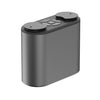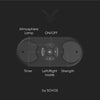Different types of diffusion technology available in the market
Ultrasonic : Aquatic dilution combined with diffusion by ultrasound provides all its effectiveness to associated essential oils. This technique allows them to be transformed into micro-particles that evaporate and are released into the air in the form of a light mist. Ultrasonic diffusers pleasantly mix olfactory, respiratory, visual and humidifying elements. Highly complete, they gently modify the atmosphere of your environment.
Nebulization : Nebulization is the diffusion technique that respects essential oils the most. Nebulization is done cold by a slight air flow, with no additive in the glass reservoir. The diffuser transforms the essential oils into fine particles that will break off and float so as to diffuse their aromas in the air. Silent and pleasant, diffusers by nebulization remain unequalled as far as aromatherapy is concerned. Each product has its own craftsman quality. Diffusers by nebulization are manufactured with noble materials like wood and glass. Each piece of glass is mouth-blown. These elements add to the natural beauty of these diffusers.
Ventilation : Diffusion by ventilation occurs thanks to the combination of two procedures, air and capillarity. Each diffuser has a receptacle occupied by an absorbent material on which a few drops of essential oil must be placed. The air propelled by the ventilator will then allow their aromas to be distributed around the room. Practical thanks to the interchangeable aspect of the absorbent pad, you can vary the desired essential oils at your leisure. Often a refined, sought-after design, the diffuser by ventilation will discretely blend into your home.
Heating : Water and imbibitions are the two main techniques of this means of diffusion. Each diffuser has a heater that, associated with a metallic part, transmits the controlled temperature directly. The use of absorbent pads will allow a greater diffusion while water dilution will offer a gentler diffusion of aromas. Practical and coming in very different styles, heating diffusers have the advantage of being light, not very bulky and transportable.
Capillarity : Since Antiquity, a number of porous materials were used to diffuse fragrances. It is this ancestral technique that today we apply mainly for fragranced diffusion. There is a very wide range of porous materials, from wood, ceramic and loofah. These materials capture and redistribute the desired aromas through evaporation. Easy to handle, they offer the possibility of creating products that are stylish, simple to use and come in various designs.









